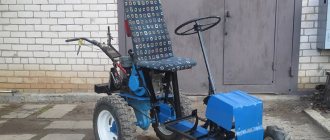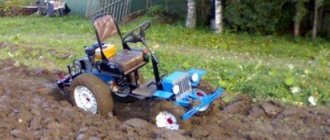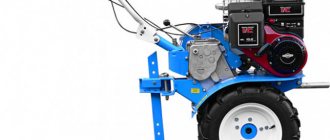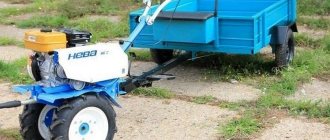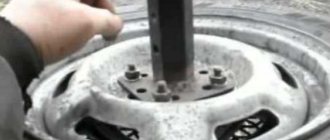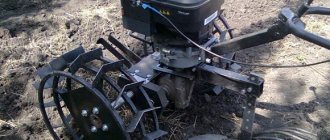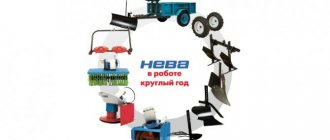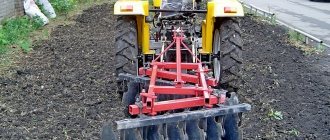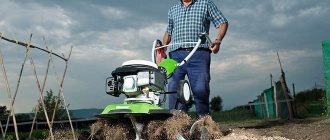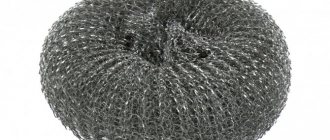What it is?
An adapter for a walk-behind tractor is a trolley, the main elements of which are a seat, a brake, a brake handle, footrests, a coupling mechanism and a frame with structural parts attached to it.
The brake of the device is located near the foot rest. Typically, such a device is equipped with two wheels, and the seat often has a lifting lever. The design of the adapter can be either universal or special: some of these varieties provide for additional fastening of various canopies.
Equipping the walk-behind tractor with an adapter practically turns the working unit into a mini-tractor with a seat that increases operator comfort.
Device
The trailer adapter for the walk-behind tractor is a two-wheeled transport trailer design. When installing more than two wheels, the load capacity increases, but the power remains the same. The operator's seat can be adapted. The design of the resulting device consists of:
- Frame – there is a ladder or spine type.
- Suspension – does not contain elastic parts. Can be rotary, bridge, axial type.
- Portal for additional accessories - available as part of the rear versions. The front types do not have it; a portal of a walk-behind mechanism is used.
- Hitch – connects the walk-behind tractor and the adapter. Characterized by reliability and stability.
- The workplace is designed for the driver’s safe stay. In some cases, it is possible to install a backup control system.
- Steering is possible when an adapter for a walk-behind tractor with a steering wheel is developed. Various design options are possible: take a ready-made steering wheel or make it yourself
The dimensions of the adapter for a do-it-yourself walk-behind tractor vary depending on the design.
Application area
If we consider in general the purpose of adapters for walk-behind tractors, then their purpose is to relieve the user and make his hard work easier. Depending on what type of auxiliary equipment is attached to the walk-behind tractor, its scope of use can expand significantly.
For example, in addition to plowing, weeding, hilling and harvesting root crops, it will be possible to remove hay, clear some types of surfaces from snow, and level the soil surface. In addition, it will be possible to transport oversized cargo.
What types of adapters for walk-behind tractors are there?
Externally, the adapter design is a small frame with two wheels, a platform for feet, a drawbar and a seat for the operator. By equipping a walk-behind tractor with such a “new thing”, you will actually turn it into a mini-tractor - working will become much more convenient, faster and easier, and the ability to adjust the seat will make the work process more comfortable.
There are several types of adapters for walk-behind tractors. In order to buy or make the most suitable option for you, you should familiarize yourself with all types of this equipment.
Based on the type of clutch, adapters are divided into adapters with steering and movable joints. Depending on the location - on the front adapters and rear ones.
Adapters can also be classified into a separate classification based on the purpose of use: with an extended drawbar for powerful large walk-behind tractors, with a shortened drawbar for small, lightweight units.
Adapter with steering
This type is on a rigid joint with a walk-behind tractor. The steering is represented by a separate unit, and options with both rear and front wheels are possible.
The walk-behind tractor becomes practically a self-propelled machine, which is quite simple and easy to operate, practically no different from motorcycles or cars.
Pros and cons of a front adapter
The unit is located in front of the walk-behind tractor using 3 screws. The maximum width of the device reaches 80 cm, length – 225 cm, and the height of the seat is no more than 71 cm. Its turning radius is smaller than the previous type and is 220 cm.
The unit is controlled by using the gas and brake pedals. At arm's length there is a handle with which you can easily change gears.
It should be noted that the maneuverability of this mechanism is inferior to that of the rear adapter . Overcoming obstacles becomes more difficult if there is cargo in the back. Load capacity is 2 times lower.
The presence of a free hitch makes it possible to attach additional devices or attachments for processing soil or transporting cargo.
Design and principle of operation
Essentially, the adapter is presented in the form of a trolley that is attached to the walk-behind tractor. After which the structure turns into a mini-tractor. The main details of such a unit:
- a frame to which other constituent elements are attached;
- driver's seat with lift lever;
- 2 wheels;
- clutch device;
- wheel axle.
In this video we will analyze the front adapter:
Frame
It is one of the most important elements of the device, since other elements are connected to it. Therefore, it must be made of high-quality and durable materials.
Driver's seat
One of the main advantages of the adapter is a comfortable seat for the operator.
Wheels
There are 2 types of wheels available - metal and rubber. The former are used for heavy types of work in the field. The latter are designed for driving on dirt roads.
Clutch device
The hitch is responsible for connecting the attachments and the mechanical unit itself. This fastening is defined as one of the most important, therefore it is made of high-strength metals - steel or cast iron.
See also: Anti-gravel on thresholds - do-it-yourself treatment and coating with anti-gravel
The length of such a device is about 2 meters, width – 80 centimeters.
Depending on the clutch, the following design options can be considered:
- with movable clutch. This device is the lightest. The clutch here is located in the front, but control in this case is more difficult, since it is necessary to deploy the entire power unit;
- with steering. The clutch here is rigid, and control is achieved through a mechanical steering unit. This control is easier to use, but more difficult to produce.
There are different adapters for walk-behind tractors of different performance. For mechanisms with low power - with a short mount, for powerful ones - with a long one.
Preparatory stage of adapter manufacturing
The adapter has a simple design, but its manufacturing procedure cannot be called simple. Initially, you need to take into account the drawings and dimensions, which will help you create a device without any defects.
You need to acquire the following materials and tools:
- Electric drill;
- Welding;
- Electric hacksaw;
- File;
- Square;
- Sheet of steel with a thickness of 5 millimeters;
- Several square pipes with a diameter of one inch;
- A set of fastenings.
Key structural elements are manufactured as follows:
- Hitch. Installed on the frame and secured with bolts. The coupling is two welded pieces of square pipes and a piece of water pipe. The latter is inserted into the rod with a welded tee;
- Wheel fixation unit. Two pieces of pipe 10 centimeters long are welded at right angles. The horizontal section is inserted into the mounting pipe and securely fixed with a bolt. An axle and bearings with wheels are attached to a vertical blank.
When all the tools are prepared and the main parts are made, you can assemble the adapter.
Advantages and disadvantages
Adaptive steering of a walk-behind tractor is convenient because:
- eliminates the need to walk behind motor vehicles;
- the traction potential of the walk-behind tractor is fully realized;
- the functionality of agricultural equipment increases;
- transportation of the unit to a specific processing area is simplified;
- easier control - no longer requires a lot of operator effort;
- the structure can be disassembled if necessary;
- sufficient balance is achieved on all axes.
The disadvantages include an increase in fuel consumption, which after modification takes one and a half times more. However, these losses are justified by the ease of management and saving a colossal amount of time that the gardener spends when working with the land.
Varieties
Adapters with steering can be classified according to the type of wheel arrangement. The steering gear is performed in the format of a separate unit. The steering wheels can be located at the front or rear.
As for the position of the steering gear, this depends on the design features and spare parts, because during operation it is impossible to avoid repairs and replacement of worn parts.
Models in which the adapter is located at the front are called front-steering varieties. In such modifications, the engine is a kind of tractor for the entire unit.
If the adapter is located at the rear, and the walk-behind tractor has to pull it behind it, such a device is called rear-wheel drive. In other words, if the adapter is located in front of the walk-behind tractor, it is a front-type product, and if at the back, it is a rear-type product.
The choice of one or another option is made by the buyer himself, based on his own preferences.
For example, the front version is more suitable for loosening and plowing the cultivated soil. Here, in addition to the power of motor vehicles, there is no need for an overview of the site. If you need to hill up the crop being grown, then the rear analogue is better suited for such purposes.
However, you can take a closer look at the option where the adapter is located closer to the drive axis. In this case, the operator’s weight will create additional load, preventing the walk-behind tractor from jumping out of the ground while the equipment is operating.
Based on the variety, adapters can be classified into body and bodyless. The former involve the transportation of goods, the latter are more suitable for cultivating the soil. Depending on the power of the unit, the adapters are connected to the walk-behind tractor using a long or short drawbar. The first modifications are used on heavy equipment, the second are used on light equipment.
Plowing with a walk-behind tractor with an adapter: instructions
The quality of plowing improves significantly if you do this together with an adapter. The functionality of the unit increases to the level of a tractor. The plowing process is easy but measured. For processing virgin soil, devices weighing over 100 kilograms are better suited.
Soil treatment occurs in several stages. It is best to process damp soil. It is important to change the direction in which plowing occurs every year.
Tags: section, bolts, trailer, weld, ready, seat, two, apparatus, needed, drawbar, necessary, option, drive, should, square, worth, welding, work, different, create, any, height, operation, bushings, legs, place, adblock, depends, gearbox, structurally, varieties, reliability, separate, further, front, hitch, take, reliably, general, bracket, labor, friend, provides, especially, differs, track, owner, first, main, must
How to install?
Let's look at the principle of installing an adapter with a steering wheel using the example of a model for a KTZ walk-behind tractor with a steering column. Connecting the adapter to the walk-behind tractor begins with installing the trailer on the pin of the walk-behind tractor, which is located in its front part. The knot is secured with a cotter pin.
After this, you need to move the gas to its place under the seat, carrying it with the original cable. To do this, use a 10mm wrench and a screwdriver, remove the throttle control lever, remove the top plug under the seat, and lay the cable. If necessary, change the bolt, since depending on the adapter model, it may be larger than necessary.
See also: Benefits of Realme 7 Pro
Next, tighten the bolts with a 10mm wrench. When moving the gas, make sure that the cable does not interfere anywhere. Remove the steering wheel from the walk-behind tractor and unhook the clutch and gearbox release cables.
Next, remove the steering wheel using a stand for ease of use. Having removed the steering wheel, remove the support and begin installing the pedals. At this stage of work, use a cable with an adapter plate, which is included with the adapter.
The plate is installed on the wing of the walk-behind tractor and secured with a bolt and nut. The lever screwed to the cable is placed in place of the roller bracket. After this, install the second cable, secure it and attach it to the installed bracket, fix it until the moment allows the cable to move.
Now you need to set the forward gear to the right pedal. There is no need to remove it for this. At the same time, adjust the components, checking the forward tension . After this, reverse is installed.
Homemade adapter
An adapter for Neva walk-behind tractors can be purchased at an agricultural equipment store from. It is available on the market as the Neva APM 350 cultivator adapter for walk-behind tractors.
It is important to pay attention to the fact that it is also compatible with other agricultural equipment from this manufacturer. For example, the adapter can be used as a rotary adapter for a Neva motor-cultivator mower.
However, a homemade adapter helps save money. Moreover, it is much more pleasant to use and can be repaired at home at any time of the day.
There are several types of adapters to the Neva
Homemade adapters for Neva walk-behind tractors come in two types:
- Heavy, which, in turn, are divided into long and short.
- Lightweight (installed on cutters).
There are also front and rear devices, depending on the drive.
More detailed information regarding the drives is provided below.
Front
In the case of a front adapter for a walk-behind tractor with or without steering, the unit is placed behind the walk-behind tractor and is controlled in the same way as a motorcycle. This model is the most popular due to its ease of use.
This design is easy to use and easy to transport.
Rear
If you decide on an adapter for a rear-wheel drive Neva walk-behind tractor, you need to make it in front of the entire device.
This arrangement is very convenient for performing various types of work in the garden, when you cannot do without attachments from the back or front.
Full
This device also comes with all-wheel drive.
In this case, the unit can be located in front or behind. However, a significant difference in characteristics from the above-mentioned varieties is that four wheels are simultaneously involved in the work. This design is more reminiscent of a miniature tractor.
Important! This adapter drive is the most powerful, although not popular.
The most powerful adapter - complete
Do-it-yourself walk-behind tractor adapter: simple and complex options
Work on a plot of land, be it loosening, digging or hilling, takes a lot of time and effort. Therefore, many gardeners, in order to facilitate the work of cultivating the land, purchase auxiliary special equipment - walk-behind tractors. Using this universal unit, you can perform a whole range of diverse work, starting with cleaning the site and cultivating the land, and ending with transporting the harvested crop and any cargo. But it is impossible to weed, hill up or simply remove snow and construction waste without attachments - an adapter. A specially equipped cart with a seat, which turns a walk-behind tractor into a mini-tractor, is quite expensive in stores. Making an adapter for a walk-behind tractor with your own hands is a completely feasible task, which can be completed by an owner with a technical creative streak.
With the help of this attachment you can significantly simplify the use of a walk-behind tractor. After all, it acts as a transitional link connecting the unit itself with other functional elements: attachments for planting and hilling potatoes, flat cutters, a plow... By installing the equipment, you can automate gardening work as much as possible. For example, when using special equipment with attachments, you can increase the operating speed from 5 to 10 km/h.
There are several types of adapters. In general, the design is a trolley attached to the rear of the walk-behind tractor, equipped with a comfortable seat
Some models are equipped with a lifting lever, which greatly simplifies the control of the mechanism and the movement of the unit itself around the site. Other adapters, in addition to performing agricultural work, can also be used for transporting goods. They are equipped with a special body. Depending on the functional value, the adapters can have short or long drawbars. Models with short drawbars are designed to work with light walk-behind tractors, and those with long drawbars are designed to work with heavier units.
How to choose a walk-behind tractor for your garden, read here: https://diz-cafe.com/tech/kak-vybrat-motoblok.html
There are also models on sale with a telescopic drawbar, as well as those in which the track width can be adjusted.
The adapters are fixed to the walk-behind tractor using a single, enlarged hitch, which consists of two parts: the first part is necessary for connecting the equipment to the unit. And the second acts as an adjustable adapter between the equipment itself and its lifting mechanism. To increase the number of implements used simultaneously, the adapters are equipped with a double universal hitch.
A simple adapter model consists of a metal frame. It is made from a pipe with a rectangular cross-section 1.7 meters long. At one end of the pipe, a 0.5 meter long pipe is welded perpendicularly, which will serve as the basis for attaching the stands for the adapter wheels. The height of the racks themselves from the wheel axis to the top point is 0.3 meters.
To make the structure, you can use wheels removed from a garden cart. They can be installed on bushings, which are quite simple to do on a regular lathe. Bearings of the appropriate size are put on the finished bushings
After this, the braces must be attached by welding to the central pipe and adapter wheel bushings. The length of the products depends on the angle of their inclination relative to the structure. The square frame of the adapter can also be made to any size. In our case, this is a frame of 0.4x0.4 meters. To equip attachments, channel No. 10, 0.4 meters long, is welded to the rear end of the frame. The assembly and connection of the side pipes of the structure is carried out using bolts.
A lever for adjustment is also welded to the frame. It has three “elbows” 20, 30 and 50 cm long. To increase the applied force, the adjustment lever is equipped with an additional lever 75 cm long. The coupling unit of the structure can be purchased at the store or made independently. Regardless of whether it is a production coupling or a self-made one, special attention should be paid to its reliability. The service life of the attachment depends on its quality.
The seat is placed on a metal support, which is welded to the central pipe. The adapter is ready for use.
To manufacture a multifunctional device, you need to prepare:
- Steel pipes and angles;
- Sheet steel;
- Two wheels;
- Comfortable seating;
- Welding machine and set of tools.
This adapter is a multifunctional model. It can be used for basic agricultural work and transporting goods over uneven terrain over short distances. The structure can be equipped with agricultural implements such as a plow, harrow, hiller, and potato digger. During the winter months, you can attach a snow scraper to the adapter for clearing snow.
The main elements of the equipment are: frame and coupling devices, as well as wheelset and seats
The process of producing an adapter at home takes place in several stages.
And this is an idea! How to upgrade a walk-behind tractor into a snow blower: https://diz-cafe.com/tech/kak-peredelat-motoblok-v-snegouborshhik.html
Stage #1 - drawing up a kinematic diagram
To ensure the balance of the structure and prevent additional overloads at the design stage, it is necessary to draw up a kinematic diagram. You can make it yourself or use a ready-made version.
This circuit is designed for the manufacture of an adapter designed to work on the Neva walk-behind tractor.
Stage #2 - production of main parts
When making and assembling a frame, it is important to provide for the arrangement of a fork with a bushing. It is necessary to ensure free rotation of the trailer.
The frame of the structure is made of metal pipes and angles
The body of the structure is made of steel sheet. The height of its sides is made no less than 30 cm.
When making stands for the adapter wheels, you can use the diagram below.
The simplest option for manufacturing a coupling assembly is a 15 cm long pin, which is stuck into the hole in the drawbar of a U-shaped walk-behind tractor. The disadvantage of this option is rapid wear: under the influence of a freely rotating trailer, the holes for the hitch quickly break. To reduce wear, it is advisable to lengthen the U-shaped chain.
Stage #3 - seat installation
The seat is secured to the spinal frame of the adapter beam, stepping back 80 cm from the front edge. It is fixed with bolts. The adapter is ready. All that remains is to check the functionality of the multifunctional device.
4 options for making a trailer for a walk-behind tractor with your own hands: https://diz-cafe.com/tech/pricep-dlya-motobloka-svoimi-rukami.html
To extend the service life and increase the attractiveness of the structure, all metal elements must be painted
Rate this article: Share with friends!
diz-cafe.com
Recommendations for use
Regardless of the type of assembled and connected product, you need to start working with it by taking into account safety regulations. Before starting the engine, you need to conduct a visual inspection of the equipment to eliminate visible damage and malfunctions. Do not add fuel to the fuel tank while the engine is running.
If you hear an unusual noise when you turn it on, you need to stop the engine and identify the cause of the problem.
Do not use gasoline of inappropriate brands or fuel mixed with oil and other impurities. Before each start, you need to check the oil level, since this is often the reason the engine stops.
In order to extend the service life of motorcycles, a new product must be run-in. It will contribute to the trouble-free functioning of the walk-behind tractor.
During this process, the working surfaces of the parts are usually worked out. The duration of running-in, as a rule, varies for products of different brands and modifications. In some varieties it can be up to 20 hours or more. At this time, you should not load the equipment to the maximum extent.
See also: Benefits and harms of lactose-free milk: an alternative to classic dairy
One recommendation is to change the oil after the first five hours of operation. As for warming up the engine, this should be done at medium speeds without load for about three minutes.
Based on the modification of the walk-behind tractor, for the first hours of its operation it is necessary to operate the unit in first gear (with the gas lever in the middle position). It is important to try to avoid not only maximum, but also minimum speed . At the end of using the equipment, you need to check the tightness of the threaded connections.
As for the cultivated soil, it is better to cultivate simple soil in the first hours. In addition, you need to take into account that rolling in is not done on rocky and clay soil.
Before work, you need to inspect the area and remove stones and large debris. In general, when working with motorized equipment, you need to constantly monitor its cleanliness and check the fastening strength of the accessible elements of the adapter and walk-behind tractor, including attachments.
Don't forget to tighten any loose fasteners. You also need to remember about timely maintenance.
Maintenance and storage
As a rule, you need to check the oil level every time you turn it on, and replace it at least once every six months. The air filters are checked before turning on the unit. Clean it when it gets dirty or once every three months.
The sump tank is cleaned every six months. If it is necessary to replace consumables, they try to buy original parts or those with similar quality characteristics.
They will help extend the life of agricultural equipment and will not cause engine failure. As for cleaning the air filter, this is necessary to maintain the working condition of the carburetor.
Do not use a solvent with a low flash point for this, as this is flammable and can lead not only to a fire, but also to an explosion. You cannot use equipment without an air filter, because this causes accelerated engine wear.
Repairs are carried out in a well-ventilated area with the engine turned off. In this case, it is necessary to ensure a sufficient level of ventilation in the work area. Exhaust gases are hazardous to human health and inhalation can be fatal. Motor vehicles should be stored in a dry, ventilated area .
During the summer season, it is not recommended to leave it outside, especially if the base of the operator’s seat is made not of plastic, but of wood. In order to extend the quality and performance characteristics, when storing the unit outdoors, you need to cover it with a tarpaulin cover.
If you do not plan to use agricultural machinery for more than three months, gasoline is poured out of the fuel tank, it is cleaned, and the position of the gas lever is checked. If necessary, disconnect the wheels.
Sources
- https://stroy-podskazka.ru/motobloki/adapter/
- https://sadovaja-tehnika.com/motobloki/navesnoe-oborudovanie/adapter/
- https://MoyMotoblok.ru/navesnoe-oborudovanie/samodelnyj-adapter-dlya-motobloka-svoimi-rukami-chertezhi/
- https://vsemotobloki.com/navesnoe-oborudovanie/dlja-svoimi-rukami.html
- https://stroy-podskazka.ru/motobloki/adaptery-s-rulevym-upravleniem/
- https://vsemotobloki.com/motobloki/neva/adapter-na-motoblok-neva.html
Did the article help you?
Andrey
Ask questions
Ask questions and write answers in the comments

